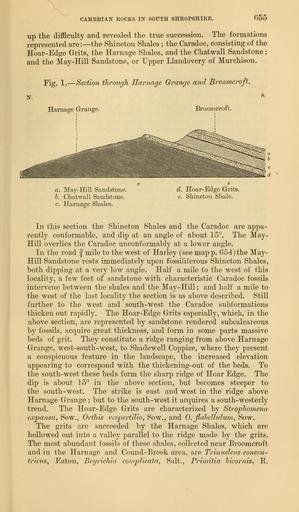MAKE A MEME
View Large Image

| View Original: | The_Quarterly_journal_of_the_Geological_Society_of_London_(12736739694).jpg (1866x3200) | |||
| Download: | Original | Medium | Small | Thumb |
| Courtesy of: | commons.wikimedia.org | More Like This | ||
| Keywords: The Quarterly journal of the Geological Society of London (12736739694).jpg CAMBRIAN ROCKS IN SOUTH SHROPSHIRE <br> 655 <br> up the difficulty and revealed the true succession The formations <br> represented are ” the Shineton Shales ; the Caradoc consisting of the <br> Hoar-Edge Grits the Harnage Shales and the Chatwall Sandstone ; <br> and the May-Hill Sandstone or Upper Llandovery of Murchison <br> Fig 1 ” Section through Harnage Grange and Broomcroft <br> N <br> Harnage Grange <br> Broomcroft <br> a May- Hill Sandstone <br> b Chatwall Sandstone <br> c Harnage Shales <br> d Hoar-Edge Grits <br> e Shineton Shale <br> In this section the Shineton Shales and the Caradoc are appa- <br> rently conformable and dip at an angle of about 15° The May- <br> Hill overlies the Caradoc unconformably at a lower angle <br> In the road f mile to the west of Harley see map p G54 the May- <br> Hill Sandstone rests immediately upon fossiliferous Shineton Shales <br> both dipping at a very low angle Half a mile to the west of this <br> locality a few feet of sandstone with characteristic Caradoc fossils <br> intervene between the shales and the May-Hill ; and half a mile to <br> the west of the last locality the section is as above described Still <br> further to the west and south-west the Caradoc subformations <br> thicken out rapidly The Hoar-Edge Grits especially which in the <br> above section are represented by sandstone rendered subcalcareous <br> by fossils acquire great thickness and form in some parts massive <br> beds of grit They constitute a ridge ranging from above Harnage <br> Grange west-south-west to Shadewell Coppice where they present <br> a conspicuous feature in the landscape the increased elevation <br> appearing to correspond with the thickening-out of the beds To <br> the south-west these beds form the sharp ridge of Hoar Edge The <br> dip is about 15° in the above section but becomes steeper to <br> the south-west The strike is east and west in the ridge above <br> Harnage Grange ; but to the south-west it acquires a south-westerly <br> trend The Hoar-Edge Grits are characterized by Strophomena <br> expansa Sow Orthis vespertilio Sow and 0 flabellidum Sow <br> The grits are succeeded by the Harnage Shales which are <br> hollowed out into a valley parallel to the ridge made by the grits <br> The most abundant fossils of these shales collected near Broomcroft <br> and in the Harnage and Cound-Brook area are Trinucletis concen- <br> irieus P'aton Beyrichia convplicata Salt Primitia bicomis B 35818830 110705 51125 Page 655 Text 33 http //www biodiversitylibrary org/page/35818830 1877 Geological Society of London NameFound Beyrichia NameConfirmed Beyrichia EOLID 13110271 NameBankID 3435888 NameFound Orthis vespertilio NameConfirmed Orthis vespertilio NameFound Primitia NameConfirmed Primitia EOLID 13110265 NameBankID 4308841 NameFound Shales NameFound Strophomena expansa NameConfirmed Strophomena expansa Biodiversity Heritage Library The Quarterly journal of the Geological Society of London v 33 1877 Geology Periodicals Smithsonian Libraries bhl page 35818830 dc identifier http //biodiversitylibrary org/page/35818830 smithsonian libraries Information field Flickr posted date ISOdate 2014-02-24 Check categories 2015 August 26 CC-BY-2 0 BioDivLibrary https //flickr com/photos/61021753 N02/12736739694 2015-08-26 19 56 33 cc-by-2 0 PD-old-70-1923 The Quarterly journal of the Geological Society of London 1877 Photos uploaded from Flickr by Fæ using a script | ||||